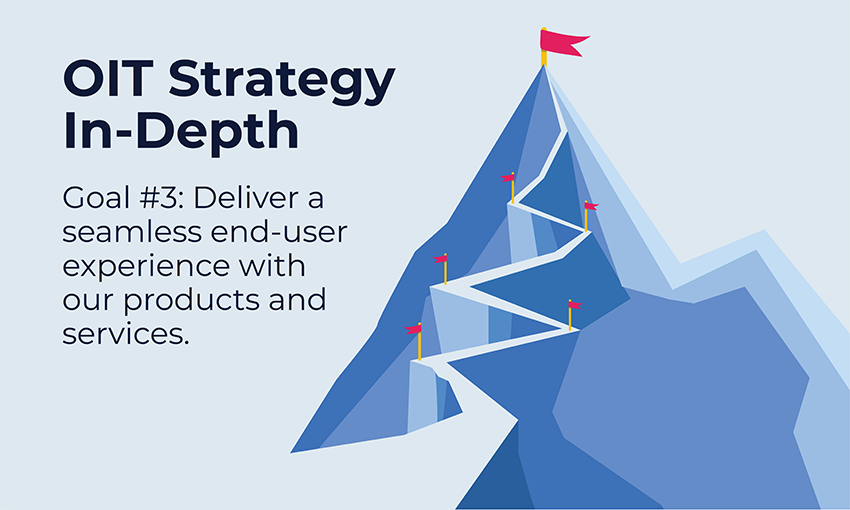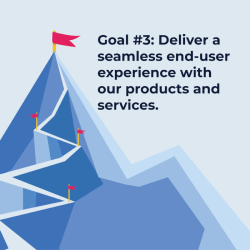Collaboration Paves the Way to a Seamless End User Experience

It’s difficult to design a frictionless end user experience without knowing your target audience’s needs. That’s why collaboration is the driving force behind our goal to deliver a seamless end user experience, the third of OIT’s five strategic goals.
The focus areas of this goal include accessibility initiatives, employee satisfaction, the future of digital work, and streamlining identity management and data access workflows.
“Of these things that we've started looking into, it turns out that the way to accomplish them and reduce friction often goes through the path of collaboration,” says OIT Director and Chief Information Officer Rajiv Uppal.
Collaborating often means disrupting old ways of doing things, according to Uppal. It helps us build a collective knowledge of end user experiences and challenges so that OIT can deliver better services.
“Collaboration is sometimes hard,” Uppal says, “but it is so necessary, because without this collaboration, without us breaking our pattern of working the way we have been working, without disrupting the way we've been doing things, we are going to find it hard to become frictionless.”
To develop a seamless user experience, OIT’s initiatives include, but are not limited to, the following:
- Delivering a best-in-class employee experience: It’s common knowledge that when employees are satisfied with their jobs, they’re more productive, able to maintain focus, and avoid burnout. That’s why this initiative is crucial to achieving OIT’s third strategic goal. OIT recognizes that highly satisfied staff are an asset. A seamless end user experience can help remove barriers staff face so that they can effectively collaborate on policy and program implementation, delivering better services faster.
“Providing our employees with a best-in-class experience, that's always been top of mind,” Uppal says. “If we do not deliver a best-in-class experience to the employees, employees in turn will not deliver the best-in-class experience to the people.”
A seamless experience isn’t possible unless it’s accessible.
“We need to do a way better job on how we make sure that not just the documents we produce, but the systems we bring in and the systems we create, are all accessible,” Uppal says.
OIT is striving to incorporate Section 508 as-a-Service (508 SaaS) to support project teams in embracing accessibility.
In January 2021, the CMS Section 508 Program officially launched its first reiteration of the 508 project, increasing CMS's accessibility reach across the agency. OIT partnered with CMS Office of Hearings and Inquiries (OHI), Office of Equal Opportunity and Civil Rights (OEOCR), Office of Human Capital (OHC), and Office of Security, Facility, and Logistics Operations (OSFLO) as a part of the Accessibility Team at CMS.
With OHI as the lead, the group formed the Accessibility Integrated Project Team to streamline communication, system enhancements, training, and issue/complaint resolution. Promoting accessibility best practices was another team goal. According to Antoinette Johnson, Director of the Division of Investment Oversight and Governance (DIOG), this collaborative initiative “was designed to encourage early dialogue between the Section 508 Program technical SMEs and IT project teams.”
From these consultations, the 508 team provides accessibility guidance and recommendations to developers. As a result, developers have a better understanding of user needs and how to incorporate accessibility into the design elements of new systems and applications.
“The good news is having early discussions not only eliminates future re-work due to noncompliance and employee access issues, but it also sets the stage for developing best-in-class systems and applications for all, supporting our culture of inclusiveness,” Johnson says.
To aid this effort, the group is developing a communication strategy to improve end user communication and mature Section 508 issue processing, according to Cora Tracy, Director of the IT Capital Planning Group.
“Having a strong and intentional 508 presence will not only increase awareness and resources to our communities, but will also support strengthening CMS’s commitment to diversity, equity, inclusion, and access,” says Monica Kay, Senior Technical Advisor and Health FFRDC Program Manager, IT Capital Planning Group.
- Creating easy access to data products: To understand how to improve access to data, OIT first wants to understand the goals and challenges of developing an enterprise-level data strategy.
That’s one purpose of projects such as Easy Access to System Information (EASi). OIT is exploring whether the agency’s silos of data need to be separate or whether a common source of data would better serve operational needs.
“We’re working to integrate and reuse System Census data with the iterative development of EASi, so OIT customers have less information to enter for existing systems, and IT governance members have more information quickly available for their reviews,” says David Dougherty, Enterprise Architect for the Division of Enterprise Architecture.
OIT will leverage human-centered design (HCD) research to understand some of the data access challenges. HCD puts user experiences, pain points, and input at the center of development. The research will aid in the creation of personas, use cases, and a journey map. Personas humanize the end user, essentially painting a picture of their characteristics, behaviors, and how they use, or could potentially use, a product (use cases).
These findings will map out the steps an end user takes to access data. This journey map seeks to answer the question, “What path does the end user take to retrieve data and what challenges do they encounter along the way?” The answers to this question will ultimately inform the solutions used to streamline and optimize data access.
Staff across CMS also will collaborate to define data access and usage policy standards as well as metadata collections to establish a shared understanding of data limitations, regulations, and the scope of the CMS data ecosystem.
- Leading and executing the Digital Future of Work vision, with a tech-enabled, hybrid approach: OIT was well-prepared for a digital future when the COVID-19 pandemic arrived, which enabled a quick and easy transition to remote work. OIT will continue working to stay ahead of the game by identifying technological needs and bridging gaps in the experiences of remote, onsite, and hybrid workers. On the horizon, OIT expects to enhance access to collaboration, communication, and self-service tools to enable real-time, seamless responses to employee needs.
- Streamlining Identity Management by incorporating two main drivers: the user and security: Identity management is a means of ensuring the right users have the right access to the right technology. It involves creating a framework of policies to manage and streamline system access. For this initiative, OIT will identify solutions that address the complexities that arise from multiple systems, processes, and infrastructures working together to manage identity.
“When we talk about identity management, and we started going through what we want to achieve on identity management, it became pretty obvious that all this rests in different parts of OIT, and for us to build a program that provides a frictionless experience for our end users, whether it's bennies (beneficiaries) or whether it's employees, we are going to have to work together,” Uppal says.

